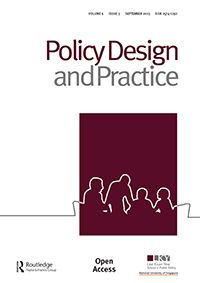‘Design for policy’ from below: grassroots framing and political negotiation
IF 2.6
Q1 PUBLIC ADMINISTRATION
引用次数: 2
Abstract
Abstract Whilst design politics is an increasingly topical focus in the design field, in practice, design for policy has been normatively presented as a people-centric approach to public policymaking devoid of political or ideological agendas. Up to now, design for policy has exclusively been conceived as embedded within governmental structures, thus adopting a technocratic, internal, and top-down approach to, and understanding of, public policymaking. We argue that most often, this understanding and practice of design for policy establishes and mediates public problems from the standpoint of the government body addressing those problems. In this paper, we take a new and distinct point of departure to design for policy in which design is implicated in the practice of policymaking from below through processes of collective action. Design for Policy from Below moves from an intra-governmental lens to a negotiated exchange between social actors and government. In turn, this informs strategic collective action required to gain political support and leverage efforts to pressure power structures to acknowledge and adopt policy frames and options. To this end, we examine the conflictual power dynamics and negotiation-based approaches to influencing government policymaking processes and model the messy interplay between government-led policymaking and the activities of social innovators aiming at changing policy outcomes. Finally, we synthesize these insights into a conceptual model offering a novel viewpoint on how we can more critically understand the politics at play in design theory and practice engaged with policymaking.自下而上的“政策设计”:基层框架和政治谈判
虽然设计政治在设计领域越来越受到关注,但在实践中,政策设计已经被规范地呈现为一种以人为本的公共政策制定方法,没有政治或意识形态议程。到目前为止,政策设计一直被认为是嵌入在政府结构中,因此采用了技术官僚的、内部的、自上而下的方法来理解公共政策制定。我们认为,大多数情况下,这种对政策设计的理解和实践,是从解决这些问题的政府机构的角度出发,建立和调解公共问题。在本文中,我们采取了一个新的和独特的出发点来设计政策,其中设计涉及通过集体行动的过程从下面制定政策的实践。“自下而上的政策设计”从政府内部的视角转向社会行动者和政府之间的协商交流。反过来,这为获得政治支持和利用努力向权力结构施压以承认和采用政策框架和备选方案所需的战略集体行动提供了信息。为此,我们研究了影响政府决策过程的冲突权力动态和基于谈判的方法,并模拟了政府主导的政策制定与旨在改变政策结果的社会创新者活动之间的混乱相互作用。最后,我们将这些见解综合到一个概念模型中,为我们如何更批判性地理解与政策制定相关的设计理论和实践中的政治作用提供了一个新颖的观点。
本文章由计算机程序翻译,如有差异,请以英文原文为准。
求助全文
约1分钟内获得全文
求助全文
来源期刊

Policy Design and Practice
PUBLIC ADMINISTRATION-
CiteScore
10.30
自引率
4.30%
发文量
19
审稿时长
13 weeks
期刊介绍:
 求助内容:
求助内容: 应助结果提醒方式:
应助结果提醒方式:


